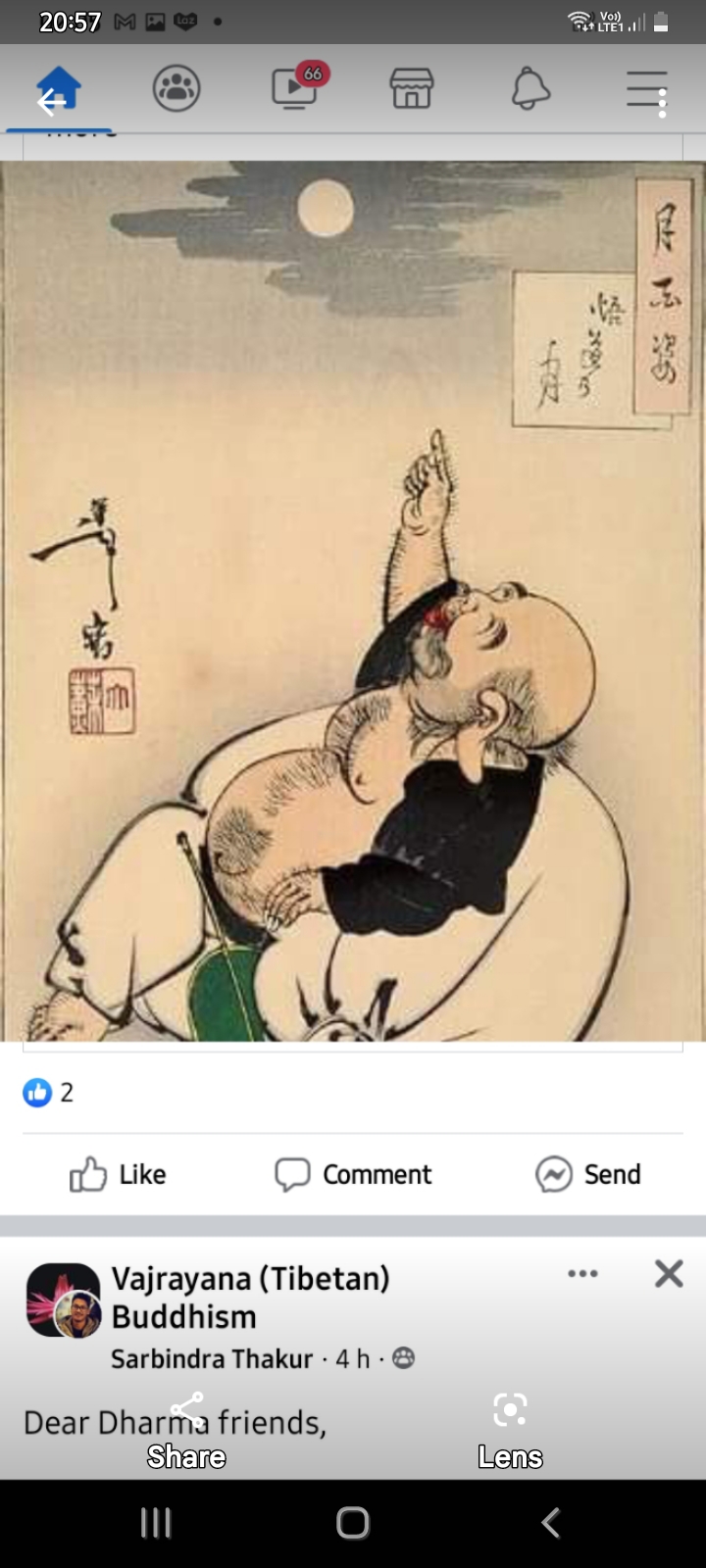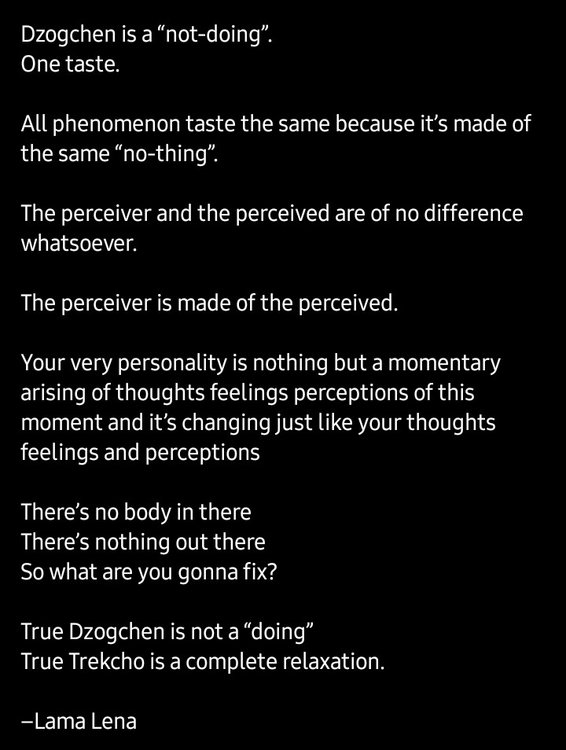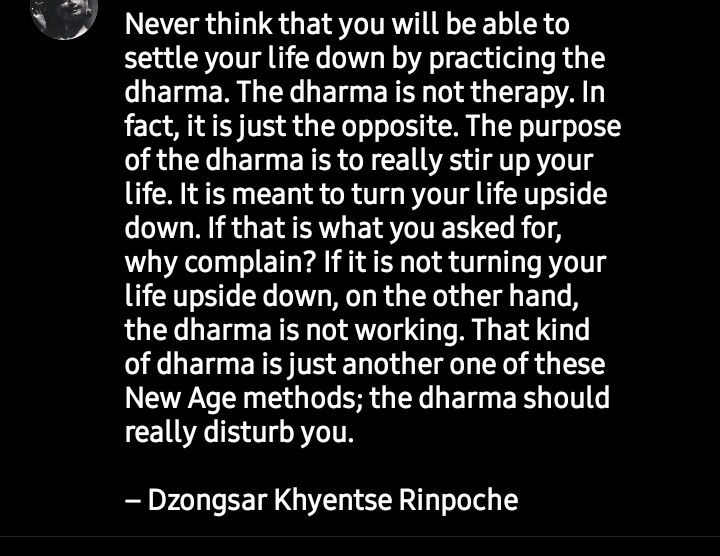-
Content count
10,542 -
Joined
-
Last visited
-
Days Won
100
Posts posted by C T
-
-
4 hours ago, steve said:For discussion’s sake -
I do consider there to be some conceptual framework in action during energy work, subtle or otherwise, but I don’t consider togal practice to be subtle energy work at all.
"The tögal practitioner works directly with the clear light that dwells inherently, “spontaneously present,” within all phenomena, using specific and exceptionally powerful exercises to reveal it within himself or herself.Tögal has a quality of instantaneousness, of immediate realization." (Rigpa wiki)
Perhaps we differ in our understanding of energy work.
-
2 hours ago, Apech said:That is all valid of course but it's not really what I was trying to say. I'm saying that 'the work' - the subtle body work involves concepts which are the way in which energy coheres or forms a body. A light body if you like.
We (collectively all of us) have been sold a 'beyond concept' model which tends to make us denigrate concepts as something to be discarded once the true nature has been realised. Of course the correct point that the true nature is not something you can think into being or imagine in the ordinary sense still stands.
I'm not following this assertion at all - that subtle energy work, and how it all coheres to form a body, involves concepts. Perhaps the structural aspect of a particular work may have to rely on a conceptual framework for it to make sense, but the actual work itself? I think it's not possible.
Togal practice is totally non-conceptual. It's very meaning points to the severance of concepts. For the simple reason concepts are bound within dualism.
-
Gorrilers generally aren't very clever at playing peek a boo

-
 1
1
-
-
We can acknowledge the need for the moon-pointing finger, but there's very little benefit in being mesmerised by both the finger and/or the moon, as is often the case.
Buddhism talks about absolute and relative truth, asserting their inseparable nature. Relative truths are all about conceptual reflections. They constantly reflect the absolute. And this is how, imo, they should be seen, and applied.
There's no necessity to dwell incessantly in analysing what to adopt (the seemingly good concepts) and what to discard when it becomes clear, concepts, as with all pithy instructions and methods and doors that open and shed light on the way, are nothing but mere expedients, each with its own shelf life.
Buddhism places equal emphasis on that which we should adopt, and that which needs to be discarded when it's time is due. Wisdom is, in a greater sense, knowing the timing with some conviction. Then we will likely be in good stead maintaining a disposition of treading lightly as we traverse our individual paths. Best to leave no footprints, just like birds flying south but leaving no traces.
-
 1
1
-
-
-
8 hours ago, stirling said:Every Nyingma teacher I ever had taught Dzogchen FIRST, then relative practices - Ngondro, etc.
Your affinity with them must be quite strong. None of the guides I've met gave the slightest hint to do the prelims after Togal.
-
 1
1
-
-
'You' are the product of causes and conditions, dependent on those parts that give rise to a convincing sense of personal identity, and ultimately an imputed creation of mind that enables a projection of 'you' as 'your' independent 'self'. ~ Paramito
-
 1
1
-
-
7 hours ago, Mark Foote said:
Although I agree that "it's not possible to intellectualise one's way to the settling into samadhi as spoken of by Gautama", I will pick a nit about the permanency of "this settled state".Gautama said that after he lectured, he returned to concentrating his mind:
And I… at the close of (instructional discourse), steady, calm, make one-pointed and concentrate my mind subjectively in that first characteristic of concentration in which I ever constantly abide.
(MN I 249, Pali Text Society vol I p 303)
“That first characteristic of concentration” is “one-pointedness of mind”, as here in Gautama’s description of “right concentration” (“right concentration”, part of “the eight-fold path” that leads to the end of suffering):
And what… is the (noble) right concentration with the causal associations, with the accompaniments? It is right view, right purpose, right speech, right action, right mode of livelihood, right endeavor, right mindfulness. Whatever one-pointedness of mind is accompanied by these seven components , this… is called the (noble) right concentration with the causal associations and the accompaniments.
(MN III 71, Pali Text Society vol III p 114; similar at SN V 17; “noble” substituted for Ariyan)
Gautama spoke of laying hold of “one-pointedness” in the induction of the first “trance”:
Herein… the (noble) disciple, making self-surrender the object of (their) thought, lays hold of concentration, lays hold of one-pointedness. (The disciple), aloof from sensuality, aloof from evil conditions, enters on the first trance, which is accompanied by thought directed and sustained, which is born of solitude, easeful and zestful, and abides therein.
(SN v 198, Pali Text Society vol V p 174; “noble” substituted for Ariyan)
I think that says that when Gautama spoke, he did not have one-pointedness of mind. He returned to that characteristic of concentration after he spoke, and with it the "first trance".
Everybody wants to go to heaven, permanently, nobody wants to have to die "the great death" over and over. I get that.
I think it's as Shunryu Suzuki described it:So, when you practice zazen, your mind should be concentrated in your breathing and this kind of activity is the fundamental activity of the universal being. If so, how you should use your mind is quite clear. Without this experience, or this practice, it is impossible to attain the absolute freedom.
(“Thursday Morning Lectures”, November 4th 1965, Los Altos; emphasis added)
Gautama described the "thought directed and sustained" of the first concentration as "the intent concentration on inbreathing and outbreathing" (F. L. Woodward's translation). That's because each of the sixteen thoughts that he outlined was to be applied or sustained in the course of an inhalation or exhalation.
Suzuki says, "when you practice zazen". Gautama spoke of the "intent concentration" that was his way of living, "especially in the rainy season".
I think I'm just learning how I should use my mind--what a relief that is, after all these years. However, I don't believe attaining "absolute freedom" is the same as remaining in "absolute freedom".Theoretically, it's possible to extend satori to a point of permanency. It's like meeting a pothole driving on a regularly-used road, the first couple of times there is Mindfulness in steering clear of it, but if Mindfulness is still required after a handful of times, then there's a problem.
-
1 hour ago, johndoe2012 said:Zen and Mahayana are not effortless, quite the opposite.
There is no effortless path in Buddhism.
The poster mentioned "non-effortless"... perhaps unintentionally? Not sure. ☺️
-
According to the Nyingma tradition -
There are several lama and dakini practices in the Longchen Nyingtik; There are four lama practices in the Longchen Nyingtik, the outer practice of guru yoga, the inner practice of Rigdzin Dipa, the secret practice of Duk-ngal Rangdrol, and the innermost practice of Tiklé Gyachen. The yidam is the Palchen Dupa, and the dakini practices are Yumka Dechen Gyalmo and Senge Dongma.
Ideally the practitioners who follow this path would do all these sadhanas before receiving Dzogchen teachings, and continue doing them afterward to support his or her practice.
Typically, in practice, practitioners are expected to have done lama Rigdzin Dupa, yidam Palchen Dupa, and dakini Yumka Dechen Gyalmo before receiving Dzogchen instructions. Then they would continue to accumulate the other sadhanas of the cycle while practicing the different stages of Dzogchen.
We need to accomplish all these sadhanas to support our Dzogchen meditation. "Doing the practice" or "accumulating the sadhana" means doing the number of recitations or spending the amount of time indicated in the retreat manuals for each practice, or practicing until there are signs of realization.
To recite a given number of mantras might seem very goal oriented, an approach that does not marry very well with dharma practice. Indeed, ideally we would practice until signs of realization appear. But that is not always very realistic. As human beings we are naturally more or less goal oriented, so instructions on time and number of recitations have been given to help hurried practitioners.
~ Yusa
-
16 minutes ago, Lairg said:Visualize/intend a bunch of timelines above, below and around you with this physical timeline in the center, stretching before and behind you.
Now move a snake dream near the various timelines.
With which timeline is the dream associated?
I find your ideas and suggestions totally inconceivable and incongruent to Buddhist praxis. Moreover, the question was meant for Steve. I understand you like to appear helpful, but would appreciate if you could perhaps do it via pm or respond to the subject by opening a new thread? I would appreciate keeping this thread as true to Buddhism as possible. Thanks.
-
In secret mantra, one lays hold of one-pointedness --
Via the body thru performing prostrations, various esoteric mudras, yantra yogas.
Via speech, thru mantra recitation. In the millions, over a few years. The mind settles easily into its own nature after doing a block of 5000 active recitations. Effort prior, but post recitation, during the settled phase, bliss, clarity and non-thought is experienced as presence, effortlessly and spontaneously. The wu wei spoken of in Daoism. Adepts are able to enter this settled state at will. In the higher yogas, this is the fruit of the completion stage. Neophytes need to crank the various practices to bring about temporal glimpses of this phase. With time, the gaps, wherein one tastes and experiences this presence in its true state, gradually expands. When habituated, it becomes permanent, which means distractions will no longer pose as obstacles to equanimity.
Via mind, thru visualisations. Yidam and mandala practices, so can't say more since it requires initiations.
It's not possible to intellectualise one's way to the settling into samadhi as spoken of by Gautama.
-
 1
1
-
-
There is nowhere in the human realm where we can escape the eight worldly dhammas of 𝐠𝐚𝐢𝐧 and 𝐥𝐨𝐬𝐬, 𝐩𝐥𝐞𝐚𝐬𝐮𝐫𝐞 and 𝐩𝐚𝐢𝐧, 𝐩𝐫𝐚𝐢𝐬𝐞 and 𝐛𝐥𝐚𝐦𝐞, 𝐢𝐧𝐜𝐫𝐞𝐚𝐬𝐞 and 𝐝𝐞𝐜𝐥𝐢𝐧𝐞 𝐨𝐟 𝐬𝐭𝐚𝐭𝐮𝐬 𝐚𝐧𝐝 𝐫𝐞𝐩𝐮𝐭𝐚𝐭𝐢𝐨𝐧. Even monastery walls offer scant protection against these eight ‘worldly winds’.
Some people might think that living alone in a cave they would be free from them at last. But, in fact, before long they would find themselves reliving past experiences. Everyone has a big file of worldly dhamma material stored in their memory, enough for years of fruitless rumination in an unwise hermit’s mind.
It is important to bear in mind that the eight worldly dhammas are included within the first noble truth, not the second. That is to say, they are not things that Buddhist practitioners need to abandon, but things that need to be fully comprehended. We cannot free ourselves of natural phenomena, but we can let go of the cravings based upon them.
The untrained mind craves to enjoy gain, pleasure, praise and social status. At the same time it craves a life without loss, pain, blame and decline in status. The more we crave the worldly dhammas we like, the more we fear and resent those we don’t. It’s not the dhammas themselves that are the problem, but our relationship to them.
Although we cannot escape the worldly dhammas, we don’t have to suffer on their account. As our understanding of them grows, our attachment to them weakens. The weaker the attachment, the more free we become.
— Ajahn Jayasaro
-
 2
2
-
-
-
Those who regard the mundane
as a hindrance to practice and life
only understand that in the mundane nothing is sacred;
what they have not yet understood
is that in sacredness, nothing is mundane.— Dogen Zenji
-
 2
2
-
-
The pomegranate is perhaps the most widely mentioned fruit in religious texts of both the East and the West.
-
 2
2
-
-
5 hours ago, Kojiro said:Recently I have heard from some nutrition and health gurus that the dark colored fruits are more "powerful and cleansing" than the light colored. Fruits like black grapes, black cherries, dark berries, pomegranates, etc., are thus considered better than oranges, apples or pears. I myself am not sure about this idea. Even though I consider the color of the fruit to be very important, I think it is probably better to eat a variety of colors, but I don't know if the darker varieties are better as they say. David Wolfe even says that this idea is in accord with the daoist teaching that the dark food is the best source of energy. What is your opinion about that? do you think the color of the fruit is important too? do you think the dark and black colors are "stronger"?
Like you, I think consuming foods and fruits/veggies of different colours is more beneficial. The Japanese Go- Syuku dietary approach, to me, makes most sense.
-
 2
2
-
-
The core teachings lead to the revelation that bliss is fundamental to life. It is ignorance of this truth that binds one to habitually revel in dualistic thoughts, assumptions, beliefs and so on, resulting in wrong views, leading to some such notions as seen in the OP.
-
 2
2
-
 1
1
-
-
-
Our Relationships
Our relationships with each other are like the chance meeting of two strangers in a parking lot; they look at each other and smile. That’s all there is between them. They leave and never see each other again. That’s life, just a moment, a step, and then it’s gone.
If you understand this, there is no time to fight. There is no time to argue. There is no time to hurt each other. Whether you think of it in terms of humanity, nations, communities, or individuals, there is no time for anything less than truly appreciating the brief interaction we have with each other.
Time is very valuable.
Don’t wait until your deathbed to understand your spiritual nature. If you do it now, you will discover resources of kindness and compassion that you didn’t know you had.
~ Chagdud Tulku
-
-
Day of the Dakini: Great Bliss 🔥
The great bliss state is the state of reality – where we actually are, right here and now. It is not some elaborate place far away from where we are. The wonderful thing about the Buddha‘s revelation, the Buddha‘s insight, is that this reality itself is the great bliss state, that which he first called “Nirvana“, the extinction of all suffering, which he came to describe as “bliss void indivisible.“
The extinction of suffering and the achievement of perfect happiness and the reality of perfect happiness is the reality of our world. This was the Buddha‘s good news. This is what he realized under the bodhi tree, where he first became enlightened. The bodhi tree was the original wish-granting gem tree. To find happiness or peace or enlightenment, we do not have to create some artificial world, a world apart from this world. We have to understand the nature of this world. And the nature of this world, when we do understand it, is revealed to us through our understanding, not from some other person just showing us something.
Our own understanding reveals the nature of the world to us as the great bliss state of emptiness and openness.
The nature of this world is superbliss, intertwined and indivisible.
~ Robert A.F. Thurman
-
 1
1
-
-
Honey on the Razor’s Edge
We have an illusion of being separate from others, the world and even ourselves, all of which we have unconsciously created. When we’re threatened or when life doesn’t please us, we start worrying, we start thinking about a possible solution. And without exception there is no person who doesn’t do this.
We dislike being with life as it is because that can include suffering, and that is not acceptable to us. Whether it’s a serious illness or a minor criticism or being lonely or disappointed—that is not acceptable to us. We have no intention of putting up with that or just being that if we can possibly avoid it. We want to fix the problem, solve it, get rid of it. That is when we need to understand the practice of walking the razor’s edge.
Spiritual practice is about understanding the razor’s edge and how to work with it.
The point at which we need to practice walking the razor’s edge is whenever we begin to be upset (angry, irritated, resentful, jealous). First, we need to know we’re upset. Many people don’t even know that upset is taking place. When we meditate and begin to know our minds and our reactions, we begin to be aware that yes, we are upset.That’s the first step, but it’s not the razor’s edge. We’re still separate, but now we know it. How do we bring our separated life together?
To walk the razor’s edge is to do that; we have once again to be what we basically are, which is seeing, touching, hearing, smelling; we have to experience whatever our life is, right this second.
If we’re upset we have to experience being upset. If we’re frightened, we have to experience being frightened. If we’re jealous we have to experience being jealous. And such experiencing is physical; it has nothing to do with the thoughts going on about the upset.
When we are experiencing nonverbally we are walking the razor’s edge—we are in the present moment. When we walk the edge, the agonizing states of separateness are pulled together, and we experience perhaps not happiness but joy.
Understanding the razor’s edge (and not just understanding it, but doing it) is what meditation practice is. The reason it’s difficult is that we don’t want to do it. We know we don’t want to do it. We want to escape from it.
If I feel that I’ve been hurt by you, I want to stay with my thoughts about the hurt. I want to increase my separation; it feels good to be consumed by those fiery, self-righteous thoughts. By thinking, I try to avoid feeling the pain. The more sophisticated my practice becomes, the more quickly I see this trap and return to experiencing the pain, the razor’s edge. And where I might once have stayed upset for two years, the upset shrinks to two months, two weeks, two minutes. Eventually I can experience an upset as it happens and stay right on the razor’s edge.
And there can be joy in the midst of physical and even emotional pain, it is not a contradiction to say that there can be ease in the midst of even great unease - there can be the taste of honey on the razors edge.
Still, it is necessary to acknowledge that most of the time we want nothing to do with that edge; we want to stay separate. We want the sterile satisfaction of wallowing in “I am right.” That’s a poor satisfaction, of course, but still we will usually settle for a diminished life rather than experience life as it is when that seems painful and distasteful.
All troublesome relationships at home and work are born of the desire to stay separate. By this strategy we hope to be a separate person who really exists, who is important. When we walk the razor’s edge we’re not important; we’re no-self, embedded in life. This we fear—even though life as no-self is pure joy. Our fear drives us to stay over here in our lonely self-righteousness. The paradox: only in walking the razor’s edge, in experiencing the fear directly, can we know what it is to have no fear.
Now I realize we can’t see this all at once or do it all at once. Sometimes we jump onto the razor’s edge and then hop off, like water dropped on a sizzling frying pan. That may be all we can do at first, and that’s fine. But the more we practice, the more comfortable we become there.
We find it’s the only place where we are at peace.
So many people say, “I want to be at peace.” Yet there may be little understanding of how peace is to be found -
Walking the razor’s edge is it.
No one wants to hear that. We want somebody who will take our fear away or promise us happiness. No one wants to hear the truth, and we won’t hear it until we are ready to hear it.
If enlightenment is not where you are standing, where will you look?
Everyday Zen
- Excerpts from Charlotte Joko Beck
-
 2
2
-
-







We live by concepts
in General Discussion
Posted
Maintaining isolation in a secluded place: If we examine well, this is conceptual meditation.
~ Garab Dorje
Patrick Quinn's elaboration on the above quote - "I think the instruction is quite clear: MAINTAINING seclusion is contrived. Because it is. You'd have to be totally aware and confident about what contrivance is first, of course, and this can really only come after long intensive retreat.
If realization has arisen, then trying to control your surroundings is actually quite manipulative and samsaric. If you have true realization it blossoms as absolute bodhicitta and its entire purpose is the liberation of all beings, and no need to "protect" or even regard a self we know not even to be there."
Knowing the limits of conceptual mind is a type of wisdom accumulation. It's imperative that such limits are recognised to avoid what Trungpa calls, "Spiritual materialism". All concepts, by default, are constructed within samsara, and serves its function within samsara. This is by no means a disparagement of concepts. What it means is that its vital to know when to be stubborn, critical, even cynical, but equally important, to know when to let go. Doesn't mean what is let gone cannot be readopted. Skillful means provide this safety net.
Gautama's last words: Everything that is constructed is impermanent. Be diligent in striving for your own emancipation. (Mahaparinibbana Sutta D16)